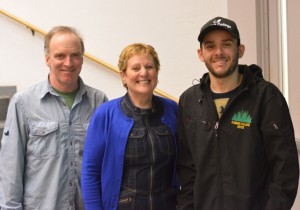Exchange student brings Brazilian forestry knowledge to Canadian classroom
Students in the Forestry Technician program heard firsthand about Brazil’s diverse climate zones and forests from Brazilian exchange student Rafael Eloy De Souza.
Rafael presented his knowledge about the forestry industry in Brazil during Program Coordinator Gerald Guenkel’s Silviculture Lecture on April 13.
Rafael came to Fleming 18 months ago to take ESL as part of the Science Without Borders program. He is currently a student in Forestry Engineering at the Federal Rural University of Rio de Janeiro.
Following his ESL program at the Sutherland Campus, Rafael moved over to the Frost Campus to take semester three and four of the Forestry Technician program.
“The biggest challenge of living in Canada was the beginning of everything. I came to Canada not speaking any English and I needed to learn the language to start to communicate with people,” said Rafael.
“My experience in the Fleming Forestry Technician program has been amazing. All this time in the program, I learned a lot with the teachers and my classmates,” he added.
“The biggest difference for me was the hands-on approach that is used in the Fleming Forestry program. In Brazil, we have more theory than practice. At Fleming, I did data collection in the forest, interpretation of data, and development of projects in software, until the final step consisted of a written project. I am excited to apply everything that I learned here in my home country.”
For many, the Amazon rainforest immediately comes to mind when thinking about Brazil’s forests. However the country has six distinct biomes (regions that contain similar climate, animals and plants) that are home to 20% of the world’s species, said Rafael.
The biomes include:
*Amazon: rain forest, 60% of the forest is found in Brazil, and it has the richest biodiversity in the world (45,000 species)
*Cerrado: most diverse savannah in the world with 11,627 native plants catalogued to date
*Atlantic Forest: one of the most threatened biomes in the world (most of Brazil’s population resides in this biome), it has a high species diversity and a tropical/sub-tropical climate
*Caatinga – a xeric shrubland and thorn forest with a very arid climate
*Pampa – grassland that also has some trees and shrubs found near waterways
*Pantanal – encompasses the world’s largest tropical wetland and is home to livestock farming and ecotourism
Brazil also has one of the largest remaining native forests in the world with forests making up about 55% of the country’s total area.
Forestry is an important industry to the country’s economy – it employs 637,000 people and exports reach a total of $9 billion annually. The biggest importers of Brazilian wood are the United States and China.
While Brazil may not have always had a reputation for managing its forests sustainably, the country is making improvements in relation to forestry degradation, said Rafael.
There are an increasing number of protected areas around the country (currently there are 886), and producers and foresters must now have a Sustainable Forestry Management Plan in place. While illegal deforestation does still occur, it has fallen by 75% in the last 10 years, said Rafael.
Planted forests are also on the upswing. They make up 1.55% of total forest area in Brazil. Most planted forests contain eucalyptus or pinus. Eucalyptus, while native to Australia, grows well in Brazil and takes just seven years to bring it to maturity, making it appealing to producers.
While Rafael is returning to his native Brazil this spring to finish his degree, he will remember fondly his time in Canada.
“My favourite Canadian experience was trying different winter activities such as skating, skiing, and building a snowman. It was different experiences that I hadn’t had in Brazil – and I think everybody knows why!” he joked.
